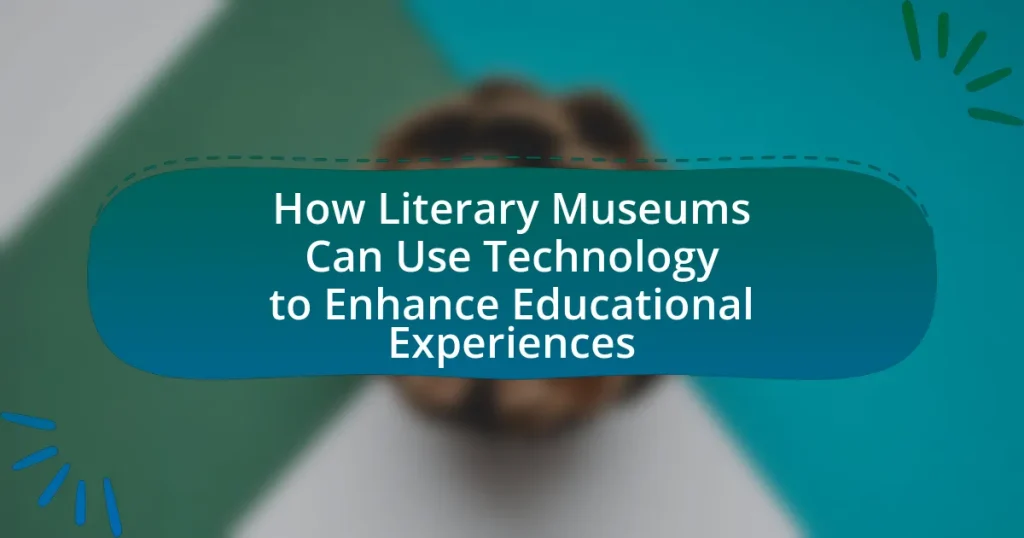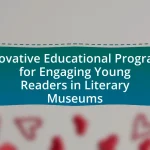Literary museums can significantly enhance educational experiences through the integration of technology, including interactive exhibits, virtual reality, and digital resources. These technologies promote visitor engagement and retention by providing immersive learning opportunities that make literary content more accessible and relatable. The article explores various types of technology currently used in literary museums, the benefits of virtual reality and interactive displays, and the importance of adopting technology to attract diverse audiences. Additionally, it addresses challenges faced by museums in implementing technology and offers strategies for overcoming budget constraints, ensuring accessibility, and effectively training staff.
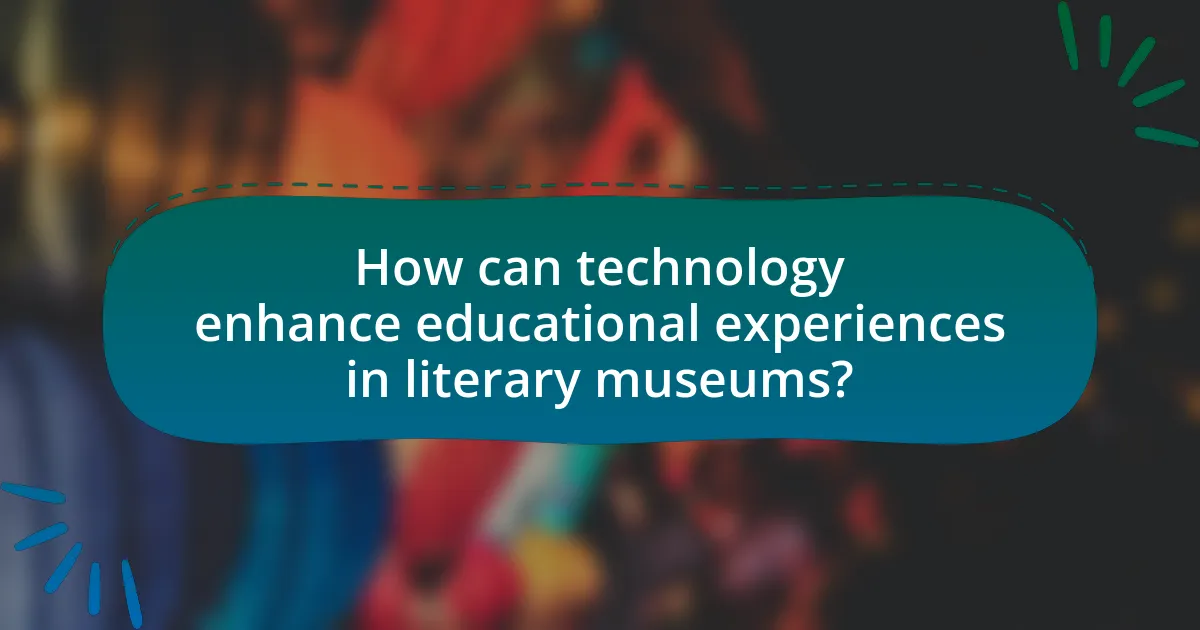
How can technology enhance educational experiences in literary museums?
Technology can enhance educational experiences in literary museums by providing interactive exhibits, virtual reality experiences, and digital resources that engage visitors more deeply. Interactive exhibits allow visitors to participate in storytelling or literary analysis, making the learning process more immersive. For instance, touchscreens can display additional information about authors or literary works, while augmented reality can bring historical contexts to life. Virtual reality experiences can transport users to significant literary settings or events, enhancing their understanding of the material. Furthermore, digital resources such as online archives and educational apps can extend learning beyond the museum visit, allowing for ongoing engagement with literary content. Studies have shown that interactive and technology-driven experiences significantly improve visitor retention and satisfaction, making technology a vital tool for literary museums.
What types of technology are currently used in literary museums?
Literary museums currently utilize various technologies to enhance visitor experiences and educational opportunities. These technologies include interactive displays, augmented reality (AR) applications, virtual reality (VR) experiences, digital archives, and multimedia presentations. For instance, interactive displays allow visitors to engage with literary works through touchscreens that provide additional context and information. Augmented reality applications can overlay digital content onto physical exhibits, enriching the storytelling aspect of the museum. Virtual reality experiences immerse visitors in the settings of literary works, offering a unique perspective on the narratives. Digital archives provide access to rare manuscripts and documents, facilitating research and exploration. Multimedia presentations combine audio, video, and text to create dynamic storytelling experiences. These technologies collectively enhance the educational value of literary museums by making literature more accessible and engaging for diverse audiences.
How do virtual reality experiences engage visitors in literary museums?
Virtual reality experiences engage visitors in literary museums by immersing them in interactive narratives that bring literary works to life. These experiences allow visitors to explore environments and scenarios from books, enhancing their understanding and emotional connection to the literature. For instance, a virtual reality simulation of a classic novel’s setting can provide context and depth that traditional exhibits may lack, making the literary experience more relatable and memorable. Studies have shown that immersive technologies can increase visitor retention of information by up to 75%, demonstrating their effectiveness in educational settings.
What role do interactive displays play in enhancing learning?
Interactive displays significantly enhance learning by promoting engagement and interactivity among learners. These displays facilitate active participation, allowing users to manipulate content, which leads to improved retention of information. Research indicates that interactive learning environments can increase student motivation and collaboration, as evidenced by a study published in the Journal of Educational Technology & Society, which found that students using interactive displays scored 20% higher on assessments compared to traditional methods. This demonstrates that interactive displays not only make learning more enjoyable but also more effective in achieving educational outcomes.
Why is it important for literary museums to adopt technology?
It is important for literary museums to adopt technology to enhance visitor engagement and educational experiences. By integrating digital tools such as interactive exhibits, virtual reality, and online resources, museums can provide immersive learning opportunities that attract a broader audience. For instance, a study by the American Alliance of Museums found that 70% of visitors prefer interactive experiences, which can lead to increased retention of information and a deeper appreciation for literary works. Additionally, technology facilitates remote access to collections, allowing individuals who cannot visit in person to engage with the museum’s offerings, thereby expanding its reach and impact.
How does technology improve visitor engagement and retention?
Technology enhances visitor engagement and retention by providing interactive experiences that captivate audiences. For instance, virtual reality (VR) and augmented reality (AR) applications allow visitors to immerse themselves in literary worlds, making the experience more memorable. A study by the American Alliance of Museums found that 70% of visitors reported increased engagement when using interactive exhibits. Additionally, mobile applications can offer personalized content and real-time information, which keeps visitors informed and encourages them to explore more. This tailored approach has been shown to increase visitor satisfaction and the likelihood of repeat visits, as evidenced by a survey indicating that 65% of users of museum apps felt more connected to the exhibits.
What are the educational benefits of using technology in literary museums?
The educational benefits of using technology in literary museums include enhanced engagement, improved accessibility, and interactive learning experiences. Technology, such as virtual reality and interactive displays, captivates visitors’ attention, making literary content more relatable and memorable. For instance, studies show that interactive exhibits can increase visitor retention of information by up to 60%. Additionally, technology facilitates access to literary resources for diverse audiences, including those with disabilities, by providing audio guides and digital content. This inclusivity broadens the reach of literary education, allowing more individuals to engage with literary works and their historical contexts.
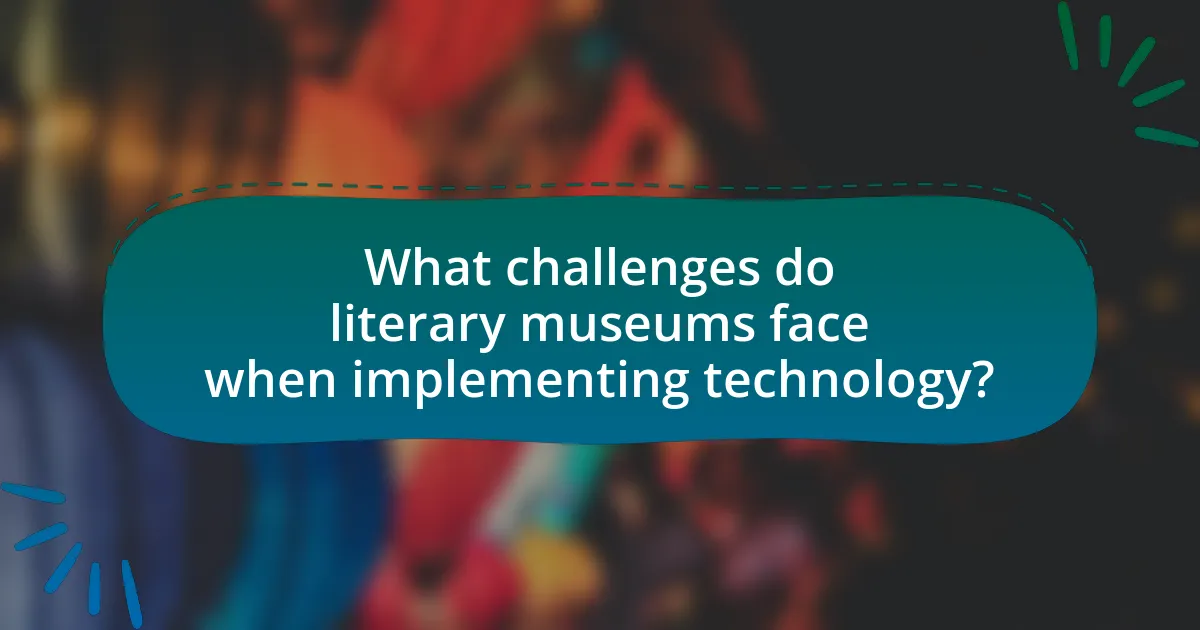
What challenges do literary museums face when implementing technology?
Literary museums face several challenges when implementing technology, including budget constraints, staff training, and audience engagement. Budget constraints limit the ability to invest in advanced technologies, which can hinder the development of interactive exhibits. Staff training is essential, as employees must be proficient in using new technologies to effectively engage visitors; however, many museums struggle to provide adequate training resources. Additionally, engaging audiences with technology can be difficult, as not all visitors may be comfortable with digital tools, leading to a potential disconnect between the technology and the intended educational experience. These challenges are documented in various studies, highlighting the need for strategic planning and resource allocation to successfully integrate technology in literary museums.
How can museums overcome budget constraints for technology adoption?
Museums can overcome budget constraints for technology adoption by seeking partnerships and grants that specifically fund technological advancements. Collaborative efforts with local businesses, educational institutions, and technology companies can provide financial support and resources. For instance, the American Alliance of Museums reported that many institutions successfully leveraged partnerships to access funding, resulting in enhanced visitor experiences through technology. Additionally, applying for grants from organizations like the National Endowment for the Humanities can provide targeted financial assistance for tech initiatives. These strategies not only alleviate budget pressures but also foster community engagement and innovation within the museum sector.
What funding opportunities are available for literary museums?
Literary museums can access various funding opportunities, including government grants, private foundations, and crowdfunding platforms. For instance, the National Endowment for the Arts provides grants specifically for arts organizations, including literary museums, to support projects that enhance educational experiences. Additionally, organizations like the Getty Foundation offer funding for projects that integrate technology into educational programming. Crowdfunding platforms such as Kickstarter and GoFundMe allow literary museums to raise funds directly from the public for specific initiatives. These funding sources are essential for literary museums to implement technological advancements that enhance their educational offerings.
How can partnerships with tech companies benefit literary museums?
Partnerships with tech companies can significantly enhance literary museums by providing innovative tools and platforms that improve visitor engagement and educational experiences. For instance, collaborations can lead to the development of interactive exhibits, virtual reality experiences, and mobile applications that allow visitors to explore literary works in immersive ways. A study by the American Alliance of Museums found that museums utilizing technology saw a 30% increase in visitor engagement, demonstrating the effectiveness of such partnerships. Additionally, tech companies can offer data analytics solutions that help museums understand visitor behavior, allowing for tailored educational programs that meet audience needs.
What are the potential drawbacks of relying on technology in educational settings?
Relying on technology in educational settings can lead to several potential drawbacks, including decreased face-to-face interaction, increased distraction, and equity issues. Decreased face-to-face interaction can hinder the development of social skills and emotional intelligence among students, as they may become overly reliant on digital communication. Increased distraction occurs when students are tempted by non-educational content available on devices, which can detract from their learning experience. Equity issues arise when access to technology is not uniform, leading to disparities in learning opportunities; for instance, a report by the Pew Research Center indicates that 15% of U.S. households with school-age children do not have high-speed internet access, which can limit educational engagement for those students.
How can museums ensure that technology does not overshadow the literary experience?
Museums can ensure that technology does not overshadow the literary experience by integrating digital tools that complement rather than replace traditional literary engagement. For instance, interactive displays can enhance understanding of literary works without detracting from the text itself. Research indicates that when technology is used to provide context, such as author interviews or historical background, it enriches the visitor’s experience while maintaining focus on the literature. A study by the American Alliance of Museums found that 70% of visitors appreciated technology that deepened their understanding of exhibits without overwhelming them. This demonstrates that thoughtful implementation of technology can enhance rather than overshadow the literary experience.
What measures can be taken to maintain accessibility for all visitors?
To maintain accessibility for all visitors, literary museums should implement features such as wheelchair ramps, accessible restrooms, and audio guides. These measures ensure that individuals with mobility challenges can navigate the museum comfortably. According to the Americans with Disabilities Act (ADA), public spaces must provide equal access to individuals with disabilities, which includes physical accommodations and assistive technologies. Additionally, offering materials in multiple formats, such as braille and large print, further enhances accessibility for visitors with visual impairments.
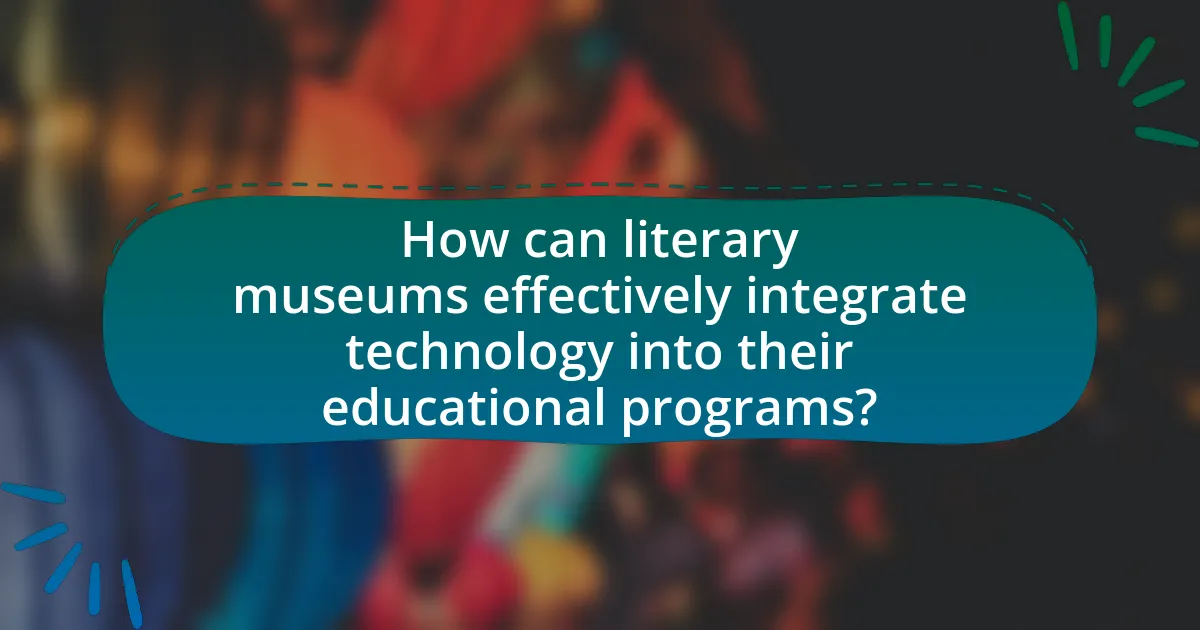
How can literary museums effectively integrate technology into their educational programs?
Literary museums can effectively integrate technology into their educational programs by utilizing interactive digital platforms, virtual reality experiences, and mobile applications. These technologies enhance visitor engagement and provide immersive learning opportunities. For instance, interactive exhibits can allow visitors to explore literary works through multimedia presentations, while virtual reality can transport users into the settings of famous novels, enriching their understanding of the context. Additionally, mobile applications can offer guided tours, quizzes, and additional resources, making the learning experience more accessible and personalized. Studies show that museums employing such technologies see increased visitor satisfaction and retention of information, demonstrating the effectiveness of these integrations in educational programming.
What strategies can be employed to train staff on new technologies?
To train staff on new technologies, organizations can implement a combination of hands-on workshops, online training modules, and mentorship programs. Hands-on workshops allow staff to engage directly with the technology, facilitating immediate application of skills. Online training modules provide flexible learning opportunities, enabling staff to learn at their own pace and revisit complex topics as needed. Mentorship programs pair less experienced staff with tech-savvy colleagues, fostering a collaborative learning environment. Research indicates that organizations that utilize blended learning approaches see a 60% increase in knowledge retention compared to traditional training methods.
How can ongoing training improve the use of technology in educational programs?
Ongoing training enhances the use of technology in educational programs by equipping educators with the necessary skills to effectively integrate digital tools into their teaching practices. This continuous professional development ensures that educators stay updated on the latest technological advancements and pedagogical strategies, leading to improved student engagement and learning outcomes. Research indicates that teachers who participate in ongoing training are more likely to implement technology in innovative ways, as evidenced by a study published in the Journal of Educational Technology & Society, which found that 78% of trained educators reported increased confidence in using technology in their classrooms.
What resources are available for staff development in tech integration?
Resources available for staff development in tech integration include professional development workshops, online courses, and collaborative learning communities. These resources provide educators with the necessary skills and knowledge to effectively integrate technology into their teaching practices. For instance, organizations like ISTE (International Society for Technology in Education) offer workshops and certification programs that focus on best practices in tech integration. Additionally, platforms such as Coursera and edX provide access to courses on educational technology, allowing staff to learn at their own pace. Collaborative learning communities, often facilitated through social media or professional networks, enable educators to share experiences and strategies related to tech integration, fostering a culture of continuous improvement.
What best practices should be followed when designing tech-enhanced exhibits?
When designing tech-enhanced exhibits, it is essential to prioritize user engagement and interactivity. Engaging users through interactive elements, such as touchscreens or augmented reality, fosters a deeper connection with the content. Research indicates that interactive exhibits can increase visitor retention of information by up to 70%, compared to traditional displays. Additionally, ensuring accessibility for all visitors, including those with disabilities, is crucial; this can be achieved by incorporating features like audio descriptions and adjustable interfaces. Furthermore, integrating storytelling techniques into the technology enhances the narrative experience, making the exhibit more memorable. Lastly, continuous evaluation and feedback collection from visitors can guide improvements, ensuring the exhibit remains relevant and effective in educational goals.
How can user feedback shape the development of technology in exhibits?
User feedback can significantly shape the development of technology in exhibits by providing insights into visitor preferences and experiences. This feedback allows museum curators and technologists to identify which interactive elements engage audiences effectively and which aspects may require improvement. For instance, a study conducted by the American Alliance of Museums found that 75% of museums that actively sought visitor feedback reported enhanced visitor satisfaction and engagement levels. By analyzing this feedback, museums can tailor their technological offerings, such as interactive displays or virtual reality experiences, to better meet the educational needs and interests of their audience.
What role does storytelling play in tech-enhanced educational experiences?
Storytelling plays a crucial role in tech-enhanced educational experiences by engaging learners emotionally and cognitively, making complex concepts more relatable and memorable. In educational settings, particularly in literary museums, storytelling can be integrated with technology such as virtual reality or interactive exhibits to create immersive narratives that deepen understanding. Research indicates that narratives can improve retention rates by up to 65% compared to traditional teaching methods, as they allow learners to connect personally with the material. This connection fosters critical thinking and encourages exploration, ultimately enhancing the overall educational experience.
What are some practical tips for literary museums looking to enhance educational experiences with technology?
Literary museums can enhance educational experiences with technology by implementing interactive digital exhibits. These exhibits allow visitors to engage with literary works through multimedia presentations, such as videos, audio readings, and interactive timelines. For instance, the British Library has successfully utilized digital storytelling to bring historical texts to life, allowing users to explore the context and significance of various literary pieces.
Additionally, incorporating augmented reality (AR) can provide immersive experiences, enabling visitors to visualize scenes from literature or interact with characters in a dynamic way. The use of AR applications, like those developed by the Museum of Modern Literature in Germany, has shown to increase visitor engagement and understanding of literary themes.
Furthermore, offering online resources and virtual tours can extend the reach of educational programs beyond the physical museum space. The New York Public Library’s digital collections and virtual exhibitions have made literary resources accessible to a global audience, enhancing learning opportunities for students and educators alike.
Lastly, utilizing social media platforms for educational outreach can foster community engagement and discussion around literary topics. By sharing content and hosting live discussions, museums can create a vibrant online community that complements their in-person educational initiatives.
